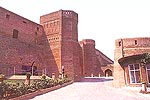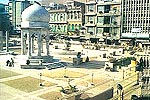No other city is quite like the old Peshawar. The bazaar within the walls is like an American Wild movie costumed as a Bible epic. Pathan tribesmen stroll down the streets with their hands hidden within their shawls, their faces half obscured by the loose ends of their turbans. (With his piercing eyes and finely chiseled nose, the Pathan must be the most handsome man on earth).
The fortunes of Peshawar are inextricably linked to the Khyber Pass.
It is situated in the Sulaiman Hills where it naturally forms the
western barrier of Pakistan. The hills dip down here, leaving a
passage sometimes as broad as 1 1/2 kms (1 mile) and sometimes as
narrow as 16 meters (42 feet).
 The pass begins near Jamrud Fort 18 kms (11 miles) from Peshawar and extends beyond the border of
Pakistan at Torkham 58 kms (36 miles) away.
The pass begins near Jamrud Fort 18 kms (11 miles) from Peshawar and extends beyond the border of
Pakistan at Torkham 58 kms (36 miles) away.
Peshawar owes its founding some 2,000 years ago to the same Kushans. In the second century A.D, Kanishka, the greatest of the Kushan kings, moved his winter capital here from Pushkalavati, 30 kilometers (20 miles) to the north. His summer capital was north of Kabul at Kapisa, and the Kushans moved freely back and forth through the Khyber Pass between the two cities, from which they ruled their enormous and prosperous empire for the next 400 years. Sher Shah Suri, successor or rather, the usurper of his son's throne, turned Peshawar's renaissance into a boom when he ran his Delhi-to-Kabul Shahi Road through the Khyber Pass. The Mughals turned Peshawar into a 'city of flowers' (one of the meanings derived from its name) by planting trees and developing gardens.
In 1818, Ranjit Singh captured Peshawar for his Sikh Empire. He
burned a large part of the city and cut the trees shading its many
gardens for firewood. The following 30 years of Sikh rule saw the
destruction of Peshawar's own Shalimar Gardens and of Baba's
magnificent fort, not to mention the dwindling of the city's
population by almost half. As much as the Sikh rule had been hated,
its British replacement aroused little enthusiasm. More or less
continuous warfare between the British and the Pathans necessitated
a huge British garrison.
 When the British built a paved road through the Khyber Pass, they needed to build numerous forts
and pickets to guard it.
When the British built a paved road through the Khyber Pass, they needed to build numerous forts
and pickets to guard it.
The mighty Balahisaar Fort lies on both eastern and western approaches to the Peshawar city. It is a massive frowning structure and when a tourist passes under the shadow of its huge battlements and ramparts he/she gets mesmerized by its majestic beauty. The only significant remaining Moghal mosque in Peshawar was built by Mahabat Khan in 1670 A.D. The mosque is a fine specimen of Moghal architecture of Emperor Shah Jehan's period. The interior of the prayer chamber has been lavishly decorated with floral work and calligraphy.
There are a number of interesting places in Peshawar. The Peshawar Museum, the Forest Museum, The Shahi Bagh, the Jinnah Park, the Khyber and Tatara Parks etc all add-up to form a complete galore package for tourists. Peshawar is a wonderously developed city offering a host of intresting spots ready to catch the attention of visitors. A must see for all tourists.


